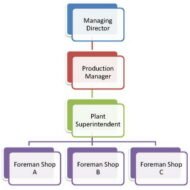Posted by Managementguru in Glossary, Human Resource
on Dec 3rd, 2014 | 0 comments

This HR Glossary pertains to ‘A’ series terminologies Ability Aptitude or competence, the skill or proficiency needed to perform certain tasks. Ability test An assessment instrument used to measure an individual’s abilities, mental or physical skills level (i.e. problem solving, manual dexterity, etc.). Absenteeism Referred to as the habitual failure of employees to report for work when they are scheduled to work. Absolute ratings A rating method where the rater assigns a specific value on a fixed scale to the behavior or performance of an individual instead of assigning ratings based on comparisons between other individuals. Abstract reasoning The process of perceiving issues and reaching conclusions through the use of symbols or generalizations rather than concrete factual information. Acceptance theory of Authority A manager’s authority rests on his or her subordinate’s acceptance of his or her right to give orders and to expect subordinate’s compliance with them. Accessibility The extent to which a contractor’s or employer’s facility is readily approachable and does not inhibit the mobility of individuals with disabilities, particularly such areas as the personnel office, worksite and public areas. Accessible format Materials that are designed in alternate formats such as Braille, audiotape, oral presentation or electronically for individuals with visual impairments. Accident and Health Benefits Employee fringe benefits paid usually through employer funded insurance plans. Accountability The responsibility placed on an individual or group for their own or others’ actions, conduct, performance, projects, etc. Accreditation A process of external quality review and certification by a recognized body that evaluates individuals, colleges, universities and educational programs to assure they are performing the functions that they claim to be performing in a competent manner. Achievement test A standardized testing instrument used to measure how much an individual has learned or what skills he or she has attained as a result of education, training or past experience. Acquisition The process of acquiring control of another corporation by purchase or stock exchange. Action learning A learner-driven, continuous learning process where learning revolves around the need to find solutions to real problems. Active learning The process of learning new knowledge, skills and behaviors through taking specific actions or performing specific tasks. Active listening A manner of listening that focuses exclusively on what the other person is saying and validates understanding of both the content of the message and the emotions underlying the message to ensure exact understanding. Activities of daily living (ADL) The personal care activities which are essential to an individual’s everyday living, including eating, bathing, grooming, dressing, mobility and toileting. Action-centered Leadership A theory of leadership which focuses on what leaders actually have to do in order to be effective,rather than on the personal qualities that they need to be good leaders, and which believes that leadership can be taught. Adjunct program A supplemental training tool that applies programming principles to existing instructional modules, materials, texts, manuals, etc., that are designed to direct the learner to specific areas within the module. Adjudicator: Aa person who gives a decision on a problem, an adjudicator in an industrial dispute. Administrative service organization (ASO) A term used to define an organization that provides outsourced solutions to meet the administrative and HR needs of the client with the client retaining all employment-related risks and liabilities. Administartive Officer Office employee responsible for managing the office, running errands and assisting the executive or boss, typing, filing, and other office related duties as required by the specific job. Adverse action Any act by an employer that results in an individual or group of individuals being deprived of equal employment opportunities. Adverse impact A substantially different rate of selection in hiring, promotion or other employment decision that works...

Posted by Managementguru in Business Management, Human Resource, Organisational behaviour, Principles of Management
on Mar 10th, 2014 | 0 comments

Line and Staff Authority LINE AUTHORITY: It is that authority which a superior exercises over his subordinates to accomplish primary objectives of the organization. The superior issues orders and instructions to his sub ordinates to complete the tasks. This authority is delegated to those positions or elements of the organization which have direct responsibility for accomplishing the primary enterprise objectives. The flow of authority is always in the downward direction from the superior to the subordinate and such relationship is called LINE RELATIONSHIP that exists in all departments of an organization. ROLES OF THE LINE RELATIONSHIP: 1. As a Chain of Command: Line officials are in the chain of command from the highest position to the lowest position in the organization. Each successive manager exercises command over his subordinates. 2. As a career of accountability: Each executive in the line is accountable for the proper performance of the tasks assigned to him and every subordinate is answerable to his superior. 3. As a Channel of communication: Since the line relationship involves issue of instructions from the authorities and reporting from subordinates, it facilitates and serves as an effective channel of communication. Line relationship helps the organization to work properly by Providing the decisions required for functioning Furnishing reference points for the approval of proposals Serving as a means of control by setting the limits of authority Establishing authentic communication channels to make leadership process effective STAFF AUTHORITY: Literally staff implies a stick carried in the hand for support. In the context of management, it implies to those elements that help the line authorities to function effectively in accomplishing the primary objectives of the enterprise. Staff provides advice assistance and information to line managers and they are distinguished into three categories namely, personal, specialized and general staff. They reduce the burden of line authorities and they too have the right to command and extract work from their subordinates. According to Henri Fayol “staff is an adjunct, reinforcement and a sort of extension of line manager’s personality.” LINE AND STAFF CONFLICTS: As always, functional and decisional conflicts arise between line and staff members. The causes may be attributed to the following reasons. 1. Line managers grudge against the staff personnel: a) The staff authorities try to encroach upon the line managers and tell them how to do their work b) Lack of well balanced advice from the staff managers c) Staff managers are not directly accountable and sport a jealous attitude towards line authorities d) Staff managers fail to see the big picture objectively and their interests are confined to specified situations e) Staff often tend to impose their superiority on line managers 2. Staff personnel complaints against the line managers a) Line managers don’t want to listen to the suggestions of the staff and make it a point to resist new ideas. b) Lack of authority on the part of staff managers to implement their innovative ideas and hence the dependence on line authorities. c) Line managers do not utilize the services of staff personnel properly and effectively. 3. The workers’ attitude a) The authority relationships between line and staff specialists are not clearly defined most of the time b) The basic difference in attitude and perception of the line and staff managers create difficulties for the work force in carrying out orders and...

Posted by Managementguru in Business Management, Leadership, Principles of Management
on Mar 5th, 2014 | 0 comments

Management styles vary by company, level of management, and even from person to person. Let us see the different management styles practised in different parts of the world for your better understanding. Managerial practices in Asian countries The managerial practices in Asian countries like Japan, China and India are quite different from that of economically advanced countries in the west. Industrial nations are in a position to adopt managerial approaches that suits their mode of operations and nature of labor force. In Asian countries, a paternalistic or participative leadership style is followed while directive style of leadership pattern suits the west. Basically, this difference arises due to the cultural background of people influenced by their tradition. Japanese management East Asian countries like Japan have a set of cultural norms that cannot be overlooked or sacrificed for the sake of business. Their cultural instincts are very strong and they believe in life long employment. Japanese management practice lays emphasis on seniority and shows great concern for each and every employee. The objectives are set by the lower level employees and it is passed on to the top level management for approval. These proposals are scrutinized by the supervisors who tactfully suggest the necessary changes, instead of simply accepting or rejecting the proposed objectives. This creates a sense of belonging and the employees identify themselves with the goals of the company. Participative Style You cannot assure that a participative style of decision making always proves beneficial. Sometimes, managers have to show their individualism by taking tough decisions, when the situation warrants for such an action. Here the leader also becomes the firm decision maker. This is quite common in the west, where the leaders identify themselves with the profession rather than the company. Such solo decision making sometimes result in sub-optimal decisions. We are not going to compare and contrast between the various management approaches and which is better. The discussion aims at throwing light on different approaches and styles of management and how it affects the productivity of an organization. https://click.linksynergy.com/deeplink?id=omtjfcspUOE&mid=39197&murl=https%3A%2F%2Fwww.udemy.com%2Fcourse%2Fleadership-and-lean-management-masterclass%2F Collective Decision Making Japanese management relies on collective decision making (consensus), where the decision making might take time, but it is implemented quickly. The Japanese management is highlighted in this discussion to demonstrate the effectiveness of their approach which is followed by many western nations to ensure success. The novelty is in the fact that they treat people as human beings and not just another factor in production. The communication flows from bottom to top and back. Care is taken to define the problem with clarity before going for a decision. In the west, managers are criticized to come to conclusions even before defining the problem. https://click.linksynergy.com/deeplink?id=omtjfcspUOE&mid=39197&murl=https%3A%2F%2Fwww.udemy.com%2Fcourse%2Fnew-manager%2F Bureaucracy Bureaucracy still prevails in most of the Asian countries hindering the progress of business communities. What started as an amazing administrative legacy has now turned authoritarian. Even if the employee knows what the manager says is incorrect; he has to obey the instructions, just because it is issued by his superior. The people are expected to follow the instructions provided and not to question or suggest. Collective Responsibility Collective responsibility and accountability, an informal organizational structure, common organizational culture and competitive spirit makes participative management approach distinct and successful. When the leader acts as a facilitator and not a dictator, naturally the employees will try to give their best shot. Collective responsibility might sometimes lead to ambiguity of decision responsibility. But individual responsibility and accountability vouches for clear and specific decision responsibility. Quality control circle Quality control circle is another feature that distinguishes Japanese management from others. Workshops are organized in a periodic fashion to arrive at solutions for problem situations, be it worker welfare, bottlenecks or interpersonal skills. The focus is on group performance and peers help one another in enhancing the performance and...

Posted by Managementguru in Business Management, Principles of Management, Training & Development
on Mar 2nd, 2014 | 0 comments

MAN POWER PLANNING What is the meaning of man power development? This involves an accurate determination of the present and future man power needs of the enterprise. Also the assessment of the right kind of organization structure both present and projected which determines the number and kinds of managers and workers required, is called for. ELEMENTS OF MAN POWER PLANNING: 1. Present Man Power Position Analysis: An assessment and evaluation of present man power position is the first step in the process which involves data collection pertaining to name, age, educational qualification, training experience, specialized skills of the employees. This is done with the help of a man power inventory chart. 2. Man Power Inventory Chart: a) An overview of the present staffing situation of the company is known b) Prospective persons for promotion can be identified c) Future internal supply of human resource can be found out d) Lack of performance is pin pointed and either people can be replaced or trained suitably e) People on the verge of retirement are identified and plans are made to recruit suitable people to replace them f) People whose promotion is overdue but not implemented due to internal politics can be identified and justice can be done by the management. Pic Courtesy: SuccessFactors 3. Job Evaluation and Job Analysis: Job evaluation is a process to rate a job in the order of hierarchy and laying down specifications needed to carry out that job. This would high light the following information a) The nature of work done by the work force b) The method employed by them to do it c) The skills, education and training required to do it d) How a particular job is related to other jobs e) What are the physical environmental conditions to accomplish the task effectively After careful analysis a neat job description can be prepared for each job which would cover the following details. 4. Job Description: a) Name or title of the job b) Nature of duties and operations to be performed c) Authority, responsibilities and accountability d) Necessary qualification i.e., education, skills, training, experience etc. Pic Courtesy: Indiamart 5. Assessment of Long term and Short term Goals: The goals whether short term or long term is decided by the market demand, and sales forecasts. Determining these goals gives the company a clear picture as to where it is headed for in the future and the kind of man power requirement to satisfy the enterprise objectives. 6. Demand of Supply of Personnel: The demand for Labor is very high as we all know and it is inevitable for the organization to keep track in terms of man power inventory and requirement of present and future. You cannot hire any X, Y OR Z for a particular job. Inter departmental transfers can provide a temporary solution if a void is created for a specific position but it will not work out in the long run. “The ultimate objective of man power planning is to fill the demand and supply...

Posted by Managementguru in Business Management, Organisational behaviour
on Feb 25th, 2014 | 0 comments

Before embarking on the subject let us find out what delegation is and how the process occurs in an organization. What is Delegation: A manager or a superior cannot think of doing all the jobs by himself. It becomes therefore necessary to delegate some of the jobs to his subordinates to ease the pressure and assign the required authority to carry on with those tasks. This downward pushing of authority is called delegation of authority. Art of Delegation Delegation takes place when one person gives another person the right to perform work on his behalf and in his name. It is the process of entrusting part of the work by the superior to his subordinates. How to Master the Art of Delegation? PROCESS OF DELEGATION 1. Step one is Assigning Responsibility: The superior directs the subordinate to perform a task with due assistance and training. 2. Step two is Granting Authority: To accomplish the task some authority has to be given to the subordinate to procure the essential resources from the organization like materials, equipment, labor etc., 3. Step three is Creating Accountability: The subordinate is expected to accomplish the task within the stipulated time period and report to the manager regarding the acquisition, use and replacement of resources. ADVANTAGES OF DELEGATION It reduces the work pressure of the manager Leads to better decisions Speeds up decision making It improves the morale of the employees Creates a feeling of mutual trust between the superior and subordinates Helps to create a formal organization structure BARRIERS TO EFFECTIVE DELEGATION Fear of being exposed: Some superiors fear that their weaknesses might be exposed Difficulty in briefing the actual requirement- depends on the quick wit of the employees Lack of confidence in subordinates Fear of loss of power“I am OK you are OK “ attitude of the managers PRINCIPLES OF DELEGATION OF AUTHORITY Principle of Delegation by Results Expected: The authority assigned to the subordinates should be sufficient enough to ensure their ability to accomplish the results expected.Principle of Absoluteness of Responsibility: One has to understand that responsibility can never be delegated and that the superiors are responsible for the activities of their employees and the performance of the employees has to be absolute towards their superior’s expectations.Principle of Parity for Authority and Responsibility: There should be a perfect balance between assigned authority and responsibility. One cannot be held responsible for a task where he has limited authority and too much of authority with too little responsibility can prove to be dangerous.Principle of Unity of Command: If there is a single superior to listen to, conflicts will be greatly reduced and it will be easy for the subordinate to have a personal rapport with the superior.Authority Level Principle: A manager who has the authority to make certain decisions must necessarily use his discretion and should not try to overlook or pass it on to the top management.Principle of Functional Definition: The objectives, tasks, responsibility and authority must be clearly stated to the individuals involved to facilitate improved performance to accomplish enterprise objectives. Managers fail because of poor delegation. Their personal attitude comes to the forefront which makes things quite difficult. Lack of receptiveness: Some managers are not open to ideas and suggestions from the other endWillingness to let go: A superior must have the willingness to delegate authority for positions which he had left long ago.Willingness to trust subordinates: A trustful attitude makes the proceedings smoothWillingness to establish and use broad controls: The superior must establish some standards to which the objectives or tasks can be compared to and control mechanisms must be installed for evaluation purposes. Feedback from subordinates is the most important criterion that determines the effective functioning of the organization. HOW TO MAKE DELEGATION EFFECTIVE? Right person for the right jobGive sufficient authorityFree flow of informationEstablish proper controlsReward the subordinatesMake the nature and scope of the tasks clearMake the subordinate understand...










